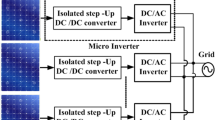Abstract
The high-gain DC-DC converters contribute a major role in renewable energy integration. The typical voltage of solar PV cells can be as low as 10–12 V and therefore, for its efficient transmission and utilization, a DC-DC converter that uplifts the terminal voltage is required. In this paper, a novel non-isolated DC-DC converter is proposed. It uses the technique of dividing the duty ratio such that no single switch is subjected to an extreme duty ratio. By using the divided duty operation of switches, the inductors and capacitors are charged for two operating modes. The inductors are first charged in parallel mode and then in series mode. Thus, a high gain ratio is obtained at a comparatively lesser duty ratio of the switches. The switched capacitor is also used in combination with the divided duty ratio technique which further enhances the overall gain. The prime advantage of this converter is that a wide range of gain can be obtained by varying the two duty ratios. The modes of operation, design consideration and efficiency analysis of the converter are presented. Also, the advantage of the converter is justified by comparing the suggested topology with other modern topologies in literature. The theoretical analysis is verified by simulation in MATLAB Simulink and also by the experimental setup of a 150 W prototype of the converter.










Similar content being viewed by others
References
Axelrod B, Berkovich Y, Ioinovici A (2008) Switched capacitor/switched inductor structures for getting transformerless hybrid DC–DC PWM converters. IEEE Trans Circuits Syst I 55(2):687–696
Babaei E, MashinchiMaheri H, Sabahi M, Hosseini SH (2018) Extendable nonisolated high gain Dc–Dc converter based on active-passive inductor cells. IEEE Trans Ind Electron 65(12):9478–9487
Bhaskar MS, Meraj M, Iqbal A, Padmanaban S, Maroti PK, Alammari R (2019) High gain transformer-less double-duty-triple-mode DC/DC converter for DC microgrid. IEEE Access 7:36353–36370. https://doi.org/10.1109/ACCESS.2019.2902440
Changchien S, Liang T, Chen J, Yang L (2010) Novel high step-up DC–DC converter for fuel cell energy conversion system. IEEE Trans Ind Electron 57(6):2007–2017
Chen G, Lee Y, Hui SYR, Xu D, Wang Y (2000) Actively clamped bidirectional flyback converter. IEEE Trans Ind Electron 47(4):770–779
Chen S, Liang T, Yang L, Chen J (2011) A cascaded high step-up Dc–Dc converter with single switch for microsource applications. IEEE Trans Power Electron 26(4):1146–1153. https://doi.org/10.1109/TPEL.2010.2090362
Cheng T, Dylan Dah-Chuan L, Qin L (2018) Non-isolated single-inductor Dc/Dc converter with fully reconfigurable structure for renewable energy applications. IEEE Trans Circuits Syst II Exp Briefs 65(3):351–355
Das M, Agarwal V (2016) Design and analysis of a high Efficiency DC-DC converterith soft switching capability for renewable energy applications requiring high voltage gain. IEEE Trans Ind Electr 63(5):2936–2944
Erickson RW, Maksimovic D (2001) Fundamentals of Power Electronics, 2nd edn. Kluwer, Norwell, MA, USA
Forouzesh M, Siwakoti Y, Gorji S, Blaabjerg F, Lehman B (2017) step-up Dc-Dc converters: a comprehensive review of voltage boosting techniques, topologies, and applications. IEEE Trans Power Electron 32:9143–9178. https://doi.org/10.1109/TPEL.2017.2652318
Hsieh Y, Chen J, Liang T, Yang L (2012) Novel high step-up DC–DC converter with coupled-inductor and switched-capacitor techniques. IEEE Trans Ind Electron 59(2):998–1007
Hu X, Liang W, Gao B, Ma P, Zhang Y (2019) Integrated step-up non-isolated inverter with leakage current elimination for grid-tied photovoltaic system. IET Power Electron 12:3749–3757. https://doi.org/10.1049/iet-pel.2018.6183
Jotham Jeremy L, Ooi CA, Teh J (2020) Non-isolated conventional DC-DC converter comparison for a photovoltaic system: a review. J Renew Sustain Energy 12(1):013502. https://doi.org/10.1063/1.5095811
Lakshmi M, Hemamalini S (2018) Nonisolated high gain DC–DC converter for DC microgrids. IEEE Trans Ind Electron 65(2):1205–1212
Li W, He X (2011) Review of nonisolated high-step-up dc/dc converters in photovoltaic grid-connected applications. IEEE Trans Ind Electron 58(4):1239–1250
Maheri HM, Babaei E, Sabahi M, Hosseini SH (2017) High step-up DC–DC converter with minimum output voltage ripple. IEEE Trans Ind Electron 64(5):3568–3575. https://doi.org/10.1109/TIE.2017.2652395
Padmanaban S, Bhaskar MS, Maroti PK, Blaabjerg F, Fedák V (2018) An original transformer and switched-capacitor (T & SC)-based extension for DC-DC boost converter for high-voltage/low-current renewable energy applications: hardware implementation of a new T & SC boost converter. Energies 11(4):783
Pan CT, Lai C-M (2010) A high-efficiency step-up converter with low switch voltage stress for fuel-cell system applications. IEEE Trans Ind Electron 57(6):1998–2006
Pavan Kumar TVV et al (2022) A highly consistent and proficient class of multiport dc-dc converter based sustainable energy sources. Mater. Today Proc. 56:1758–1768. https://doi.org/10.1016/j.matpr.2021.10.458
Prudente M, Pfitscher LL, Emmendoerfer G, Romaneli EF, Gules R (2008) Voltage multiplier cells applied to non-isolated DC–DC converters. IEEE Trans Power Electron 23(2):871–887
Shahir FM, Babaei E, Farsadi M (2017) A new structure for nonisolated boost Dc-Dc converter. J Circuits Syst Comput 26(01):1750012
Funding
No fund was received for the conduction of the presented work.
Author information
Authors and Affiliations
Corresponding author
Ethics declarations
Conflict of interest
There is no conflict of interest among authors to be declared.
Additional information
Publisher's Note
Springer Nature remains neutral with regard to jurisdictional claims in published maps and institutional affiliations.
Rights and permissions
Springer Nature or its licensor holds exclusive rights to this article under a publishing agreement with the author(s) or other rightsholder(s); author self-archiving of the accepted manuscript version of this article is solely governed by the terms of such publishing agreement and applicable law.
About this article
Cite this article
Pandey, A., Pattnaik, S. An advanced non-isolated high gain DC-DC converter with divided-duty ratio for renewable energy integration. Int J Syst Assur Eng Manag 13, 2865–2875 (2022). https://doi.org/10.1007/s13198-022-01752-9
Received:
Revised:
Accepted:
Published:
Issue Date:
DOI: https://doi.org/10.1007/s13198-022-01752-9




